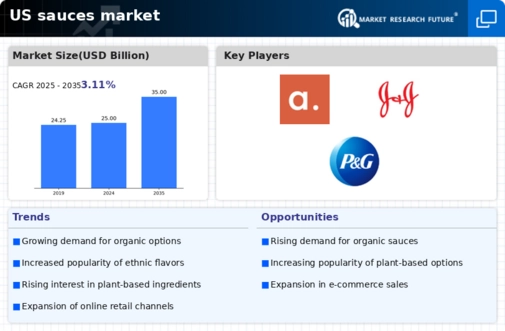Health and Wellness Trends
Health and wellness trends are significantly impacting the sauces market, as consumers become more aware of the nutritional content of their food. There is a growing demand for sauces that are lower in sugar, sodium, and unhealthy fats, as well as those that offer functional benefits, such as added vitamins or probiotics. Market data shows that health-oriented sauces have seen a growth rate of around 10% annually. This shift is prompting manufacturers to reformulate existing products and develop new offerings that align with health-conscious consumer preferences, thereby shaping the future of the sauces market.
Rising Demand for Ethnic Flavors
The sauces market in the US is experiencing a notable shift towards ethnic flavors, driven by an increasingly diverse population and a growing interest in global cuisines. Consumers are seeking authentic taste experiences, which has led to a surge in the popularity of sauces such as sriracha, chimichurri, and tzatziki. This trend is reflected in market data, indicating that ethnic sauces have seen a growth rate of approximately 15% annually. As consumers become more adventurous in their culinary choices, the sauces market is likely to expand further, catering to this demand for unique and bold flavors.
Convenience and Ready-to-Use Products
In the fast-paced lifestyle of many consumers, convenience plays a crucial role in purchasing decisions within the sauces market. Ready-to-use sauces, which require minimal preparation, are increasingly favored by busy households. This trend is supported by market data showing that ready-to-use sauces account for nearly 40% of total sales in the sauces market. The appeal of these products lies in their ability to save time while still providing flavorful options for meals. As the demand for convenience continues to rise, manufacturers are likely to innovate and expand their offerings in this segment.
Sustainability and Clean Label Trends
Sustainability has emerged as a significant driver in the sauces market, with consumers becoming more conscious of the environmental impact of their food choices. The demand for clean label products, which feature natural ingredients and transparent sourcing, is on the rise. Market data suggests that over 60% of consumers prefer sauces that are free from artificial additives and preservatives. This shift towards sustainability is prompting manufacturers to reformulate their products and adopt eco-friendly practices. As a result, the sauces market is likely to see an increase in the availability of organic and sustainably sourced options.
Increased Home Cooking and Meal Preparation
The trend of increased home cooking has positively influenced the sauces market, as consumers seek to enhance their culinary skills and create restaurant-quality meals at home. This shift has led to a rise in the demand for various sauces that can elevate home-cooked dishes. Market data indicates that sales of cooking sauces have increased by approximately 20% in recent years, reflecting this growing interest. As more individuals experiment with cooking, the sauces market is expected to benefit from this trend, with consumers looking for innovative and flavorful sauces to complement their meals.














Leave a Comment